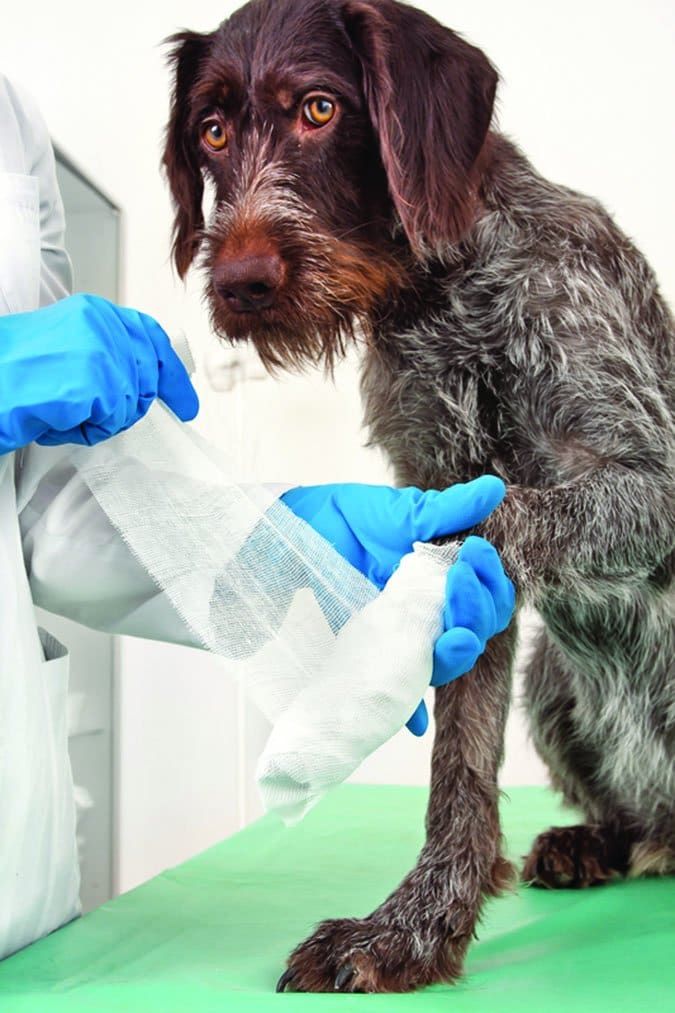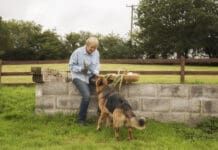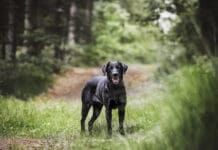Your dog’s paw pads act much like the soles of sneakers, protecting your dog’s foot and cushioning each step. Paw pads are tough, but they can still be cut by sharp objects or worn off if your dog runs hard on rough terrain. What should you do when your dog cuts or tears a paw pad?
1. Clean the wound.
Gently flush the wound with water or an antiseptic, such as diluted chlorhexidine solution. If there is obvious debris, such as rocks or glass, remove it carefully. Don’t force anything that is lodged deep into the foot.
2. Control bleeding.
Apply pressure to the wound to stop any bleeding. Use a clean towel and an ice pack if available to encourage blood-vessel constriction. If only the outer layer of the pad has been worn off, there may not be much bleeding, but deeper wounds and punctures can bleed heavily. The time it takes for bleeding to stop will vary with the severity of the wound.
3. Evaluate the damage.
Minor paw injuries can be managed at home, but more severe ones require veterinary attention. Uncontrolled bleeding is an emergency – if your dog’s foot continues to bleed after several minutes of pressure, call your veterinarian and head for the clinic. Deep or jagged cuts may require sutures for optimal healing. Your dog may need to be sedated for sufficient cleaning of the wound if there is persistent debris, such as little bits of gravel, and something that is firmly lodged in the foot will need to be surgically removed. Your dog may also need antibiotics to protect against infection. If you are at all unsure, err on the side of a vet visit – your veterinarian can give you peace of mind and can give your dog the care he needs.
4. Bandage.
Place nonstick gauze or a Telfa pad directly over the cut. If available, a dab of triple antibiotic ointment is a good idea to prevent infection. This can be secured with paper tape. Then wrap your dog’s foot using roll gauze, Vetrap, or an elastic bandage. The bandage should be snug enough to stay on, but also needs to be loose enough to allow for proper circulation to your dog’s foot. You should be able to slide two fingers under the bandage. To prevent the bandage from slipping off, wrap all the way up to and including the next joint on your dog’s leg: carpus or wrist in front, hock in back. You can also place more tape around the top of the bandage.
Keep the bandage dry. Moisture provides an entrance for bacteria to get through the bandage and into the wound. You can use a commercial bootie to protect the bandage when your dog goes outside or just tape a plastic bag over it. Most paw bandages need to be changed daily, especially if there is still bleeding or a discharge present.
For minor scrapes that look like a rug burn, a liquid bandage can be used to cover the exposed nerve endings without needing a full traditional bandage. Keep the foot elevated while the liquid bandage dries, and don’t let your dog lick it.
5. Allow time for a dogs cut paw pad to heal
Your dog’s cut paw pad will heal faster if it’s protected until fully healed. Keep him quiet, and prevent him from running or chewing at the bandage (this may require the use of an Elizabethan collar). Even after your dog’s pad has healed enough that it isn’t painful to touch, it will still be tender and vulnerable to reinjury. Avoid activities that could damage the healing pad, or use a bootie to protect the foot. Healing time will vary depending on the size of the cut.
To soothe cracked or sore paws, refer to the Soothing Dog Paw Butter recipe in our homemade gift guide.
Read our article on the 12 Items to Include in Your DIY Dog First-Aid Kit.
Kate Eldredge is a licensed veterinary technician from Plattsburgh, New York. She also trains, shows, and breeds Belgian Tervuren and is working on her canine-rehabilitation certification.







Ive tried everyone everywhere no help when we moved my dog started “pawing” people like shake she doesn’t know her own strength & scratchesxpeople all rhe time i feel weve tried everything. Shes otherwise PERFECT & so smart! but supposed to be a service dog PLEASE HELP.
Block her with your bidy and make her go sit or lay down before you open the door to let people in. If she gets up continue to block her and tell her sit or down till she stays.
Hi Ava just came home from my dogs walk n she is bleeding on her back paw and so scared but i bathed it in saltwater n now got her lying up on couch way me plus she’s got dhirrea which is RILOTTEN WOW please any as advice would be appreciated love kelly x
You can also hold the paw for an extended time, after your dog thinks it’s finished. He will pull back, don’t let go. Hold for a minute or two, while he tries to reclaim his paw. Your dog will learn that pawing at people means losing control of his/her foot. I have big guardian dogs. Had to teach them politeness ASAP.
Same with jumping on people. Hold paws, dog will want to get down, but can’t. They learn very quickly that jumping means losing control and stability. Be gentle, don’t yell. It doesn’t have to be a negative experience. After the third time, he’s going to be happy to see you without needing to paw or jump up.
True. This works EVERY TIME… only some dogs will nip at your hand. If u anticipate this and hold at the “wrist” of the dog then place it’s own paw in its mouth if it nips… when u do release them … give them a shove and say “OFF”! and turn away.
I have a dog who is a compulsive paw-er. She sits next to us on the couch and paws and paws and paws. I got her to almost stop by sitting next to her and clicking and treating as long as she was sitting with her front legs on the couch.
its sounds like the move upset her. Try turning your whole body away from her anytime she does that. Even in you are sitting down. just give her your back. Once she stops wait a minute then give her some pets and love. Mine dog paws when she wants attention and thats what I do. It helps. Otherwise contact some trainers and see what they say.
You might try a combo of “raising the reinforcement level” and “catch her being good” by making the environment more rewarding: a few times an hour, when you catch her doing something incompatible with pawing you, make a really big deal of it and deliver her favorite treat (good lying on your mat! good playing with your toy!, etc.). It probably won’t take too many days until she does more of these behaviors, or offers you other creative behaviors that you can reward. You may want to feed less as she is getting calories from treats, or if she really likes her food, use portions of her food for treating for some of the sessions.
When she paws you yell “ouch!” and remove yourself from her vicinity briefly (5 minutes).
Perhaps in all the hubbub of relocating, she hasn’t gotten as much attention as usual, or some of her favorite diversions have been overlooked.
“Don’t Shoot the Dog!” by behaviorist Karen Pryor is a short, entertaining, and informative application of learning theory to typical situations that you may enjoy.
Thanks.I think I’ll work.
Thanks again.
I agree maybe move upset your dog. Go back to basics and train: ask for sit when a person comes in, say good or click and give high value treat. Practice 10 min. Sessions many times a day with different people. Practice outside on walks approaching people. Lots of praise.
Eliz Collar: There are kinder ways to prevent dogs from bothering wounds. Suitical, for one, has various garments a dog can wear. Perhaps eliz collar are needed in certain cases but WDJ should also please offer other ideas that will be more humane to the dog
My dog ran too much and the bottom of her paw got scraped just the main one none of the toe ones did, never the less it’s healing but half of it still looks red and she seems to be in pain she doesn’t want to walk outside at all. However she is eating and drinking water. It does look like it’s swollen and wet. I do not believe it’s fractured but I’m wondering what it is we can do as to soaking it or cleaning it before we take her to the vet
Soak the paw at least once a day in warm water with Epsom salts. MIX 1/2 tbsp to 1 quart of f warm water. ( don’t let him drink it) ….Use apply Neosporin for pain/ infection. Use 2 thick gauze pads over pads , wrap with roll of gauze than wrap with vet wrap ( not to tight) VERY IMPORTANT TO KEEP DRY, CLEAN AND KEEP YOUR BABY OFF IT AS MUCH AS POSSIBLE!!! CHANGE WRAP EVERY DAY AFTER SOAKING. PADS GET INFECTED QUICKLY AND IT IS VERY PAINFUL!!!! Pads take time to heal. Good luck and lots of love and kisses to your baby
I have a dog too, he keeps on licking his paw but I see the cut, it’s not bleeding I don’t know what to do it’s been like 5 days the vet was busy so they told me to put an ice pack on his foot but he hated it what do I do?
How did you heal the wound?
Help me my dog paw injury tell me how to protect my dog paw injury contact me +919053525840
My dog is injured on his feet
I need help please I’m independent
My dauschound has a swollen back pawpad, and a puncture on it. He walks on it with no limp. He doesn’t take it away until we press on it. I put mryh on it this morning. What can I do for it. I gave him a small dose of beedrill last night.
I have 3 dogs one started with soars small ones about a month later the 2nd one has started to eat his legs and we keep the wounds clean but they seem to keep coming back one heals another starts it seems to try and heal just can’t please help me i
Have to keep trying vets tell me different things and i am lost?
My dogs back paw will not heal!!!
Been using1/2 tsp Clorox in cup warm water and put/hold on paw couple times@night. After drying Vet School of medicine in Raleigh recommended Mupirocin 3 a day. He’s had 3 rounds of antibiotics (still not healed ) pain med (gabapentin100mg) please help!!!
Cover his paw when going outside and he’s been wearing a collar for approx 4 months.